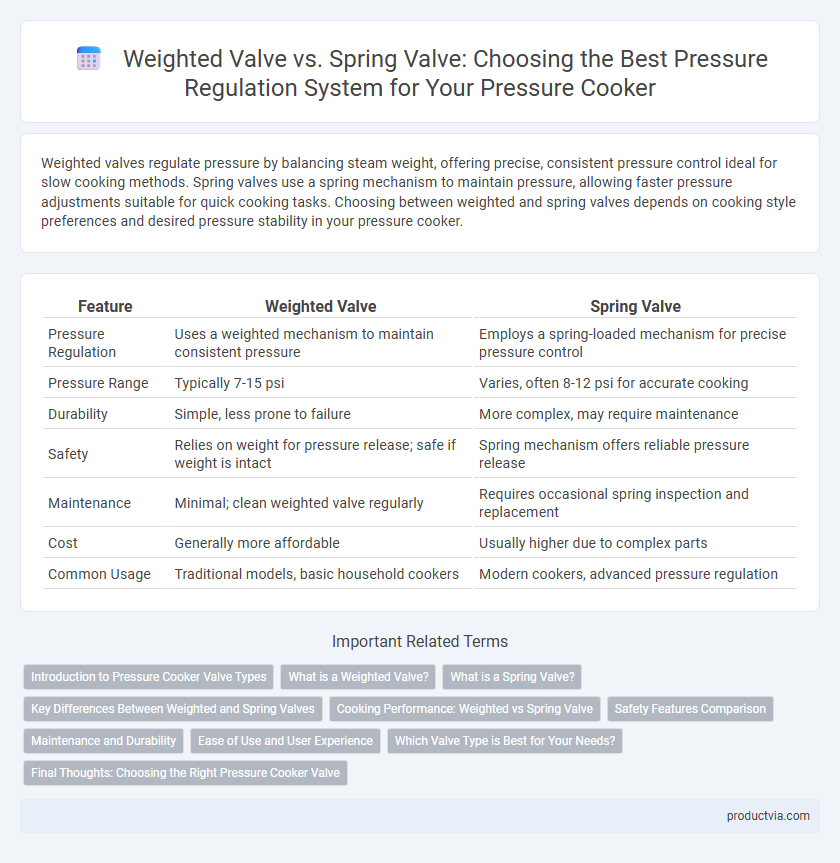Weighted valves regulate pressure by balancing steam weight, offering precise, consistent pressure control ideal for slow cooking methods. Spring valves use a spring mechanism to maintain pressure, allowing faster pressure adjustments suitable for quick cooking tasks. Choosing between weighted and spring valves depends on cooking style preferences and desired pressure stability in your pressure cooker.
Table of Comparison
| Feature | Weighted Valve | Spring Valve |
|---|---|---|
| Pressure Regulation | Uses a weighted mechanism to maintain consistent pressure | Employs a spring-loaded mechanism for precise pressure control |
| Pressure Range | Typically 7-15 psi | Varies, often 8-12 psi for accurate cooking |
| Durability | Simple, less prone to failure | More complex, may require maintenance |
| Safety | Relies on weight for pressure release; safe if weight is intact | Spring mechanism offers reliable pressure release |
| Maintenance | Minimal; clean weighted valve regularly | Requires occasional spring inspection and replacement |
| Cost | Generally more affordable | Usually higher due to complex parts |
| Common Usage | Traditional models, basic household cookers | Modern cookers, advanced pressure regulation |
Introduction to Pressure Cooker Valve Types
Pressure cooker regulation relies on two primary valve types: weighted valves and spring valves, each designed to maintain optimal pressure levels for safe cooking. Weighted valves use a simple, gravity-based mechanism to release excess steam, providing consistent pressure control ideal for traditional stovetop models. Spring valves incorporate a spring-loaded system that responds more precisely to pressure changes, often found in advanced electric pressure cookers for enhanced safety and efficiency.
What is a Weighted Valve?
A weighted valve in a pressure cooker is a pressure regulation device that controls steam release by using a heavy, calibrated weight placed on the vent pipe. This valve maintains consistent pressure by lifting the weight when the internal pressure exceeds a set level, allowing excess steam to escape steadily. Weighted valves provide reliable, gradual pressure control suitable for traditional stovetop pressure cookers.
What is a Spring Valve?
A spring valve in a pressure cooker is a safety mechanism designed to regulate internal pressure by lifting a spring-loaded disk when the pressure exceeds a set limit. This valve maintains consistent cooking pressure and prevents excessive buildup, ensuring safe operation. Unlike weighted valves, spring valves offer precise pressure control and quicker pressure release.
Key Differences Between Weighted and Spring Valves
Weighted valves regulate pressure by balancing steam release through a rotating weight, allowing for stable and gradual pressure adjustment essential in traditional stove-top pressure cookers. Spring valves use a calibrated spring mechanism to maintain a set pressure threshold, providing quick and precise pressure release suited for modern electric pressure cookers. Key differences include the weighted valve's mechanical simplicity and durability versus the spring valve's faster response time and higher accuracy in pressure control.
Cooking Performance: Weighted vs Spring Valve
Weighted valves maintain precise pressure by balancing steam release through gravity, ensuring consistent cooking temperatures ideal for delicate foods and slow cooking. Spring valves provide faster pressure response with a mechanical spring that regulates pressure but may cause minor fluctuations, suitable for recipes requiring quick pressure adjustments. Cooking performance varies as weighted valves offer steadier heat retention for uniform cooking, while spring valves deliver rapid pressure changes enhancing versatility.
Safety Features Comparison
Weighted valve pressure cookers use a heavy, calibrated weight to regulate steam pressure, offering reliable and consistent pressure control with minimal risk of sudden release. Spring valve models employ a spring-loaded mechanism to maintain pressure, but may require frequent maintenance to ensure proper sealing and pressure accuracy, potentially impacting safety. Weighted valves are often preferred for superior safety due to their simple design and clear pressure indication, reducing the chances of pressure-related accidents.
Maintenance and Durability
Weighted valves in pressure cookers offer easier maintenance due to their simple, detachable design, allowing for quick cleaning and replacement, while spring valves require more careful handling to avoid spring fatigue or corrosion over time. Durability of weighted valves tends to be higher under consistent use because they rely on gravity and mass rather than mechanical springs that may weaken or fail. Choosing between the two hinges on balancing the ease of maintenance with overall longevity and consistent pressure regulation.
Ease of Use and User Experience
Weighted valves in pressure cookers offer a straightforward, audible pressure regulation system that signals when to adjust the heat, enhancing ease of use for beginners. Spring valves provide more precise pressure control and quicker pressure release, improving user experience for those seeking accuracy and safety. Choosing between the two depends on whether simplicity or fine-tuned pressure management is the priority during cooking.
Which Valve Type is Best for Your Needs?
Weighted valves offer precise pressure control by maintaining constant pressure through the weight's specific calibration, making them ideal for traditional pressure cooking methods requiring steady heat. Spring valves respond quickly to pressure changes, providing more accurate and rapid regulation, which suits modern cooking styles demanding precise pressure adjustments. Choosing between weighted and spring valves depends on your cooking preferences, cookware compatibility, and the level of control desired for safety and recipe accuracy.
Final Thoughts: Choosing the Right Pressure Cooker Valve
Choosing the right pressure cooker valve significantly impacts cooking efficiency and safety, with weighted valves offering consistent pressure control through gravity, ideal for precise cooking needs. Spring valves provide rapid pressure changes and quick release, making them suitable for versatile cooking styles and faster meal preparation. Evaluating factors like cooking habits, pressure accuracy, and maintenance will guide selecting either a weighted or spring valve for optimal pressure cooker performance.
Weighted Valve vs Spring Valve for Pressure Cooker Regulation Infographic

 productvia.com
productvia.com